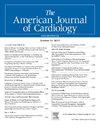Renal Denervation for Hypertension: From Innovation to Indication
IF 2.1
3区 医学
Q2 CARDIAC & CARDIOVASCULAR SYSTEMS
引用次数: 0
Abstract
High blood pressure is a common problem around the world. Although many trials attest to the value of reducing blood pressure with medication and lifestyle changes, current prevalence studies of high blood pressure show a substantial portion of the adult population with uncontrolled high blood pressure. Treatment nonadherence is part of the challenge to achieving blood pressure control and newer approaches to high blood pressure treatment, whether device based, or using agents such as silencing ribonucleic acids, have shown high levels of treatment efficacy and since they are administered in the health care setting, adherence is less of an issue. In this introduction to a special issue of the American Journal of Cardiology we will review the history of hypertension treatment and some current epidemiology highlighting the public health importance of improving blood pressure control to reap the well described benefits of lower blood pressure upon the target organs of hypertension. Subsequent sections of this special issue will focus on aspects of renal denervation, including patient selection, efficacy in blood pressure lowering, measuring success of denervation and procedural guidance for this emerging therapy in the management of uncontrolled hypertension.
肾去神经治疗高血压:从创新到适应证
高血压是世界范围内的一个普遍问题。尽管许多试验证明了通过药物和改变生活方式来降低血压的价值,但目前对高血压的患病率研究表明,相当一部分成年人的高血压未得到控制。治疗不依从性是实现血压控制的挑战之一,新的高血压治疗方法,无论是基于装置的,还是使用诸如沉默核糖核酸的药物,都显示出很高的治疗效果,因为它们是在卫生保健环境中使用的,所以依从性就不是问题了。在这篇《美国心脏病学杂志》特刊的介绍中,我们将回顾高血压治疗的历史和一些当前的流行病学,强调改善血压控制对公共卫生的重要性,以获得对高血压靶器官降低血压的良好描述。本特刊的后续部分将重点介绍肾去神经支配的各个方面,包括患者选择、降血压的疗效、去神经支配成功的测量以及这种新兴疗法在控制高血压管理中的程序指导。
本文章由计算机程序翻译,如有差异,请以英文原文为准。
求助全文
约1分钟内获得全文
求助全文
来源期刊

American Journal of Cardiology
医学-心血管系统
CiteScore
4.00
自引率
3.60%
发文量
698
审稿时长
33 days
期刊介绍:
Published 24 times a year, The American Journal of Cardiology® is an independent journal designed for cardiovascular disease specialists and internists with a subspecialty in cardiology throughout the world. AJC is an independent, scientific, peer-reviewed journal of original articles that focus on the practical, clinical approach to the diagnosis and treatment of cardiovascular disease. AJC has one of the fastest acceptance to publication times in Cardiology. Features report on systemic hypertension, methodology, drugs, pacing, arrhythmia, preventive cardiology, congestive heart failure, valvular heart disease, congenital heart disease, and cardiomyopathy. Also included are editorials, readers'' comments, and symposia.
 求助内容:
求助内容: 应助结果提醒方式:
应助结果提醒方式:


